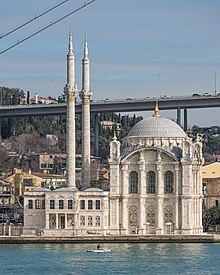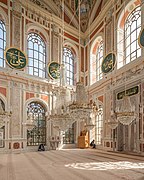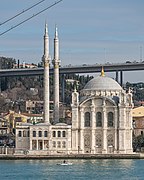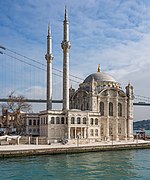Ortaköy Mosque
| Ortaköy Mosque | |
|---|---|
 Ortaköy Mosque from Bosphorus | |
| Religion | |
| Affiliation | Islam |
| Location | |
| Location | Istanbul, Turkey |
| Geographic coordinates | 41°2′49″N 29°1′37″E / 41.04694°N 29.02694°ECoordinates: 41°2′49″N 29°1′37″E / 41.04694°N 29.02694°E |
| Architecture | |
| Architect(s) | Garabet Balyan, Nigoğayos Balyan |
| Type | Mosque |
| Style | Baroque Revival |
| Groundbreaking | 1853 |
| Completed | 1856 |
| Minaret(s) | 2 |
Ortaköy Mosque (Turkish: Ortaköy Camii) officially the Büyük Mecidiye Camii (Grand Imperial Mosque of Sultan Abdülmecid) in Beşiktaş, Istanbul, Turkey, is situated at the waterside of the Ortaköy pier square, one of the most popular locations on the Bosphorus. This structure is symbolic of the district of Ortaköy as it has a distinctive view of the Bosphorus Strait of Istanbul and the Bosphorus Bridge. The mosque can be viewed from the Bosphorus Cruise that is popular among tourists, to go from the Asian side of Istanbul to the European side on a ferry boat.
History[]
Located on the site of the present-day Ortaköy Mosque, there previously was a small masjid. Built in 1720, it was ruined during the Patrona Halil Uprising in 1731.[1] The current mosque, which was erected in its place, was ordered by the Ottoman sultan Abdülmecid and built between 1854 and 1856, on the ruins of the Cantemir Palace. Its architects were Armenian father and son Garabet Amira Balyan and Nigoğayos Balyan (who also designed the nearby Dolmabahçe Palace and the Dolmabahçe Mosque), who designed it in the Neo-Baroque style.[2]
The single dome of the mosque was originally built using bricks. However, the dome developed cracks throughout time and was ready to collapse, so a new dome was reconstructed using concrete. In 1894, there was an earthquake that damaged the mosque, and it also suffered a minor fire in 1984. Thus, the structure has undergone a number of repair and restoration work in its time. Today, it is in fair shape.[3]
Features[]
It consists of a two-story "sultan apartment" which has a "U shaped" plan, a main venue with a square plan which is covered with one dome. The "sliced facades" with mounting columns are "enriched" by carvings as well as relief, giving the mosque a "dynamic appearance". There are two rows of windows providing the main venue a "good illumination".[4]
The mosque is "pint-sized" in comparison to other mosques "on the other side of the golden horn". The mosque was built in Neo-baroque style. In terms of the interior space, this mosque is modest in scale, though the inside is quite spacious with its wide, "high bay windows" which refract its reflection in water as well as daylight. Floral patterned frescoes adorn the inside of the singular dome, along with "niche-like" windows bordered by imitation curtains. Materials like marble were used to build the mihrab and minbar, pink mosaics were also used to decorate the Mihrab. The reconstructed dome was built from concrete, while stone was used to build the two, slim minarets.[5]
There are also several panels of calligraphy executed by Abdülmecid I himself, as he was a calligrapher along with being a sultan.[6]
Gallery[]

Interior view of the dome

Interior view of the dome

Ortaköy, Istanbul: view on mosque and Bosphorus bridge

Ortaköy mosque detail
See also[]
Notes[]
- ^ Türkyılmaz, Çiğdem (Spring 2015). "Interrelated Values of Cultural Landscapes of Human Settlements: Case of Istanbul". Procedia - Social and Behavioral Sciences. 222: 502–509. doi:10.1016/j.sbspro.2016.05.141.
- ^ Alan, p.62
- ^ Alaboz, Murat (July 2014). "STRUCTURAL RESPONSE OF ORTAKOY BUYUK MECIDIYE MOSQUE IN ISTANBUL". International Masonry Society: 13.
- ^ Alan, p.63
- ^ Cultural heritage and its educational implications: a factor for tolerance, good citizenship and social integration. Germany: Council of Europe Publishing. 1998. ISBN 9287135843.
- ^ Leeann Murphy (23 December 2014). Moon Istanbul & the Turkish Coast: Including Cappadocia. Avalon Travel. ISBN 9781612386140.
References[]
| Wikimedia Commons has media related to Ortaköy Mosque. |
- Hakan Alan (2010). Turkey. ASBOOK. ISBN 9789750114779.
- Baroque architecture in the Ottoman Empire
- Baroque Revival architecture in Turkey
- Beşiktaş
- Bosphorus
- Garabet Amira Balyan buildings
- Nigoğayos Balyan buildings
- Ottoman mosques in Istanbul
- Religious buildings and structures completed in 1856
- 19th-century mosques








